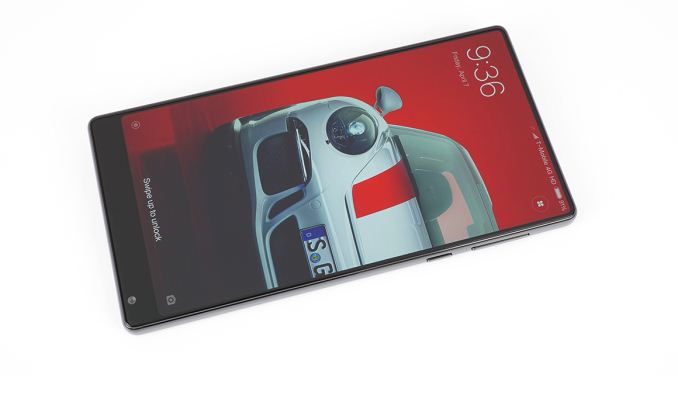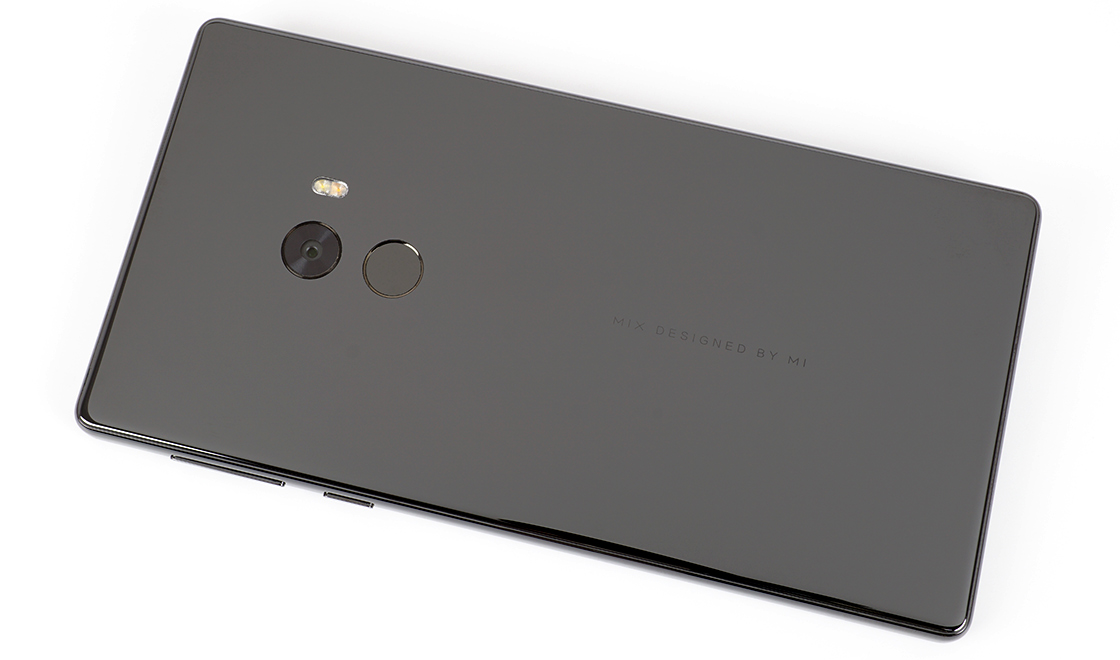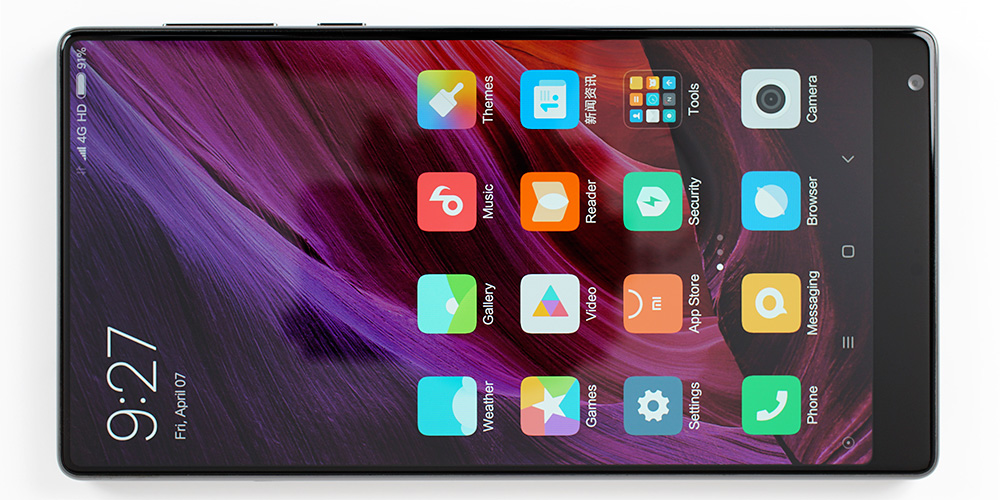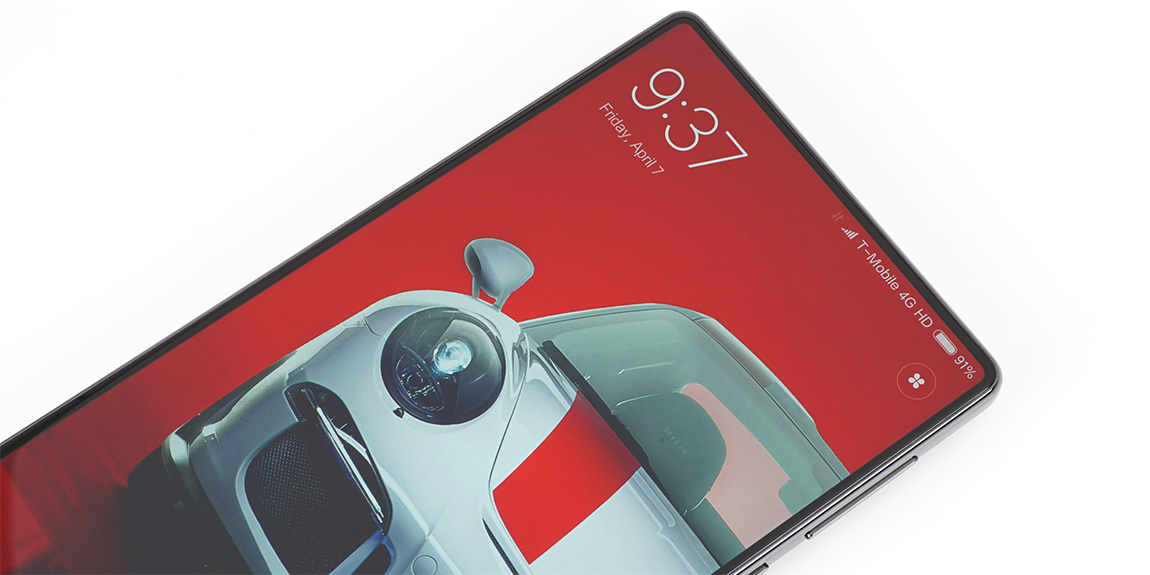Xiaomi Mi MIX: A Closer Look at the Design and Display
by Matt Humrick on April 10, 2017 7:00 AM EST- Posted in
- Smartphones
- Mobile
- Xiaomi
- Mi
- Snapdragon 821

We recently saw the release of two new smartphones with dramatically improved screen-to-body ratios, the LG G6 and Samsung Galaxy S8. Before either of these phones were announced, however, Xiaomi’s Mi MIX gave us a glimpse of the future. A pseudo-concept phone that’s being produced in limited quantities and sold in China, it combines the latest technology with innovative design, resulting in a forward-looking phone with virtually no bezels on three sides of the screen and an amazing 91.3% screen-to-body ratio, according to Xiaomi (or roughly 84% using the chassis dimensions).
Xiaomi created the Mi MIX to show off its design prowess and demonstrate its ability to produce innovative products. Xiaomi has employed new materials (ceramic) and design elements (rounded edges on the back) in the past, but by creating something as unique as the MIX, it hopes to prove that its products are as lust worthy as those that come from Apple and Samsung.
Competition among Chinese OEMs is fierce, with most of them sacrificing smartphone profit for market share. Xiaomi in particular has a reputation for creating nice-looking phones packed with high-performing hardware that are sold at lower-than-expected prices, compensating for the near-zero profit from hardware sales with recurring revenue earned through its software ecosystem. This strategy has helped fuel its rapid growth, but as the smartphone market in Asia nears saturation, it may be time to shift its focus. Xiaomi has been aggressively diversifying its product portfolio, branching out into smart home devices, UAVs, bicycles, etc., and pushing into western markets where premium phones fetch higher profit. By creating a flashy product like the MIX, Xiaomi attracts attention and improves its brand cachet, which can help it break into new markets and establish itself as a premium player that can charge more for its phones.
Encased within the shiny ceramic is a Snapdragon 821 SoC and a large 4400 mAh battery. There’s also either 4GB of RAM and 128GB of internal storage for the standard MIX or 6GB of RAM and 256GB of storage for the Mi MIX 18K. Both configurations offer flagship-class performance.
In the short time I’ve used the MIX, the only component I’ve had issues with is the fingerprint sensor. It seems less tolerant of moisture than other sensors and returns a higher rate of false negatives. It’s certainly usable, but I often found it required two or three tries to unlock the phone.
| Xiaomi Mi MIX | |
| SoC | Qualcomm Snapdragon 821 (MSM8996 Pro) 2x Kryo @ 2.35GHz 2x Kryo @ 2.19GHz Adreno 530 @ 653MHz |
| Display | 6.4-inch 2040x1080 IPS LCD |
| Dimensions | 158.8 x 81.9 x 7.9 mm 209 grams |
| RAM | 4GB / 6GB LPDDR4 |
| NAND | 128GB / 256GB (UFS 2.0) |
| Battery | 4400 mAh (16.94 Wh) non-replaceable Qualcomm Quick Charge 3.0 |
| Front Camera | 5MP, 1/5" OmniVision OV5675 PureCel, 1.12µm pixels, f/2.2 |
| Rear Camera | 16MP, 1/3.06" OmniVision OV16880 PureCel Plus-S, 1.0µm pixels, f/2.0, PDAF, Auto HDR, dual-tone LED flash |
| Modem | Qualcomm X12 LTE (Integrated) 2G / 3G / 4G LTE (Category 13/12) |
| SIM Size | 2x NanoSIM (dual standby) |
| Network | China |
| FDD-LTE | B1 / B2 / B3 / B4 / B5 / B7 / B8 |
| TDD-LTE | B38 / B39 / B40 / B41 |
| GSM | 850 / 900 / 1800 / 1900 |
| WCDMA | B1 / B2 / B5 / B8 |
| CDMA | BC0 |
| TD-CDMA | B34 / B39 |
| Wireless | 802.11a/b/g/n/ac 2x2 MU-MIMO, BT 4.2, NFC, GPS/GNSS/Beidou |
| Connectivity | USB Type-C, 3.5mm headset |
| Launch OS | Android 6.0 with MIUI 8 |
| Launch Price | 4GB/128GB: ¥3499 6GB/256GB: ¥3999 |
The MIX’s 6.4-inch IPS LCD display has a 17:9 aspect ratio, which Xiaomi divides into a traditional 16:9 viewable area with a dedicated space at the bottom of the screen for the onscreen controls. Not only does this eliminate the need for capacitive buttons in the lower bezel—keeping it as slim as possible—but it avoids UI scaling issues for apps targeting 16:9 screens.
Our review unit uses a Sharp fte716 IPS LCD panel that appears to use IGZO (indium gallium zinc oxide) thin-film transistors (TFTs) in the backplane. IGZO transistors have several advantages over the amorphous silicon (aSi) or low-temperature polysilicon (LTPS) varieties.
Every liquid crystal (LC) requires circuitry, including a transistor and a capacitor, to control its operation. These components can block some of the light transmission from the backlight, however, reducing the display’s power efficiency. The more light that passes through the backplane, the less power the backlight needs to consume to reach a given brightness.
Most IPS LCD panels use aSi TFTs. These are not naturally transparent, although, they can be made thin enough to allow at least some light to pass through them. IGZO TFTs, however, are fully transparent, which improves power efficiency by allowing more light to pass through.
IGZO’s electron mobility is also significantly higher than aSi and almost as good as LTPS, which allows smaller transistors to carry the same current. The MIX’s panel uses the smaller TFTs to increase the aperture ratio (the ratio of a pixel’s transparent and opaque areas), which further improves efficiency by allowing more light to pass through.
Most LCD displays need to continually refresh the screen, even when displaying a static image, because high leakage current in aSi and LTPS TFTs causes the capacitors in the pixels to discharge. Continuously driving the pixels in this manner increases power consumption, not just within the panel itself, but also by forcing the SoC to continuously push the contents of the frame buffer over the memory bus. To help mitigate this issue, some panels support panel self-refresh (PSR), which embeds a small amount of RAM in the panel itself to hold a local copy of the frame buffer. When displaying a static image (which is most of the time when not playing a game or watching a video), the panel can use its local copy to refresh the screen, reducing the power the SoC and busses would normally consume.
The Mi MIX’s panel does not support panel self-refresh, which would normally be a serious omission for a flagship phone; however, IGZO TFTs have significantly less leakage current than aSi and LTPS, allowing their pixels to discharge more slowly and retain their image state longer. A technology called idling-stop driving (IDS) takes advantage of this by significantly reducing the refresh rate of the screen when displaying static content, essentially achieving a similar power advantage as a display with PSR.
IGZO’s benefits not only reduce a display’s power consumption, but they are directly responsible for the Mi MIX’s most eye-catching feature: its edge-to-edge display. IGZO allowed Sharp to integrate the supporting circuitry that normally surrounds the active area of the screen into the panel itself, allowing Xiaomi to nearly eliminate the bezel on three sides.
The Mi MIX is a stunning looking phone whose nearly edge-to-edge display and shiny ceramic body make it stand out as something special. Xiaomi’s use of ultrasonic and piezoelectric technology streamlines the front by hiding two components—proximity sensor and earpiece speaker—behind the screen, fueling the illusion that you’re holding nothing but a 6.4-inch display. As the phone’s centerpiece, display performance is critical for the Mi MIX, and our analysis on the next page shows that it looks as good as the rest of the phone.













48 Comments
View All Comments
philehidiot - Monday, April 10, 2017 - link
Yeh this worries me a little. What eases my concern a little is that western "spy" agencies have access to most of our stuff anyway but you get the feeling that there is a little more professionalism and oversight going on there.... possibly...... a little.At the end of the day people quite happily throw a load of information at Facebook for "their friends" to see but not realising that if they're not paying for the product then basically they are the product. I wonder just how much my Amazon Dot is listening to me - there's an interesting criminal court case where what the Amazon box picked up will be used as evidence and I for one will be very interested to know why it recorded anything at all without the activation command being spoken and what it recorded. My Dot may be headed for the bin.
I think we have to accept that "software extras" are just the norm these days, whether they are corporations or our own governments who can just watch and listen to us as they please. Whether the Chinese or Russians are necessarily worse at this than us may just be a feature of our biases rather than based in fact but I don't think any of us actually have enough information in order to make that assessment.
If however you're on about organised crime sticking malware / spyware on there for the purposes of extracting credit card data, etc then I concur. There is evidence that large numbers of phones are being intercepted somewhere along the line and infected which is why my girlfriend's new phone got a full virus scan performed before she started putting any data on it whatsoever. Not fool proof but better than nothing. I think the risk of this kind of issue is probably higher when the phones spend more time in countries where bribing people to say, park a truck up for a few hours whilst they go for a nice break, is seen as the norm.
Drumsticks - Tuesday, April 11, 2017 - link
Per your echo comments... how do you suppose it hear an activation command without it recording your audio? It has to process the audio in order to determine if it matches the activation command, and to do that, it has to record.According to Amazon, that audio is stored locally on the device, but is not transmitted to Amazon servers. I'd probably trust them on it; there isn't really a way to do this without recording, and it'd be pretty easy to tell if there were an increased number of transmissions to amazon servers when you were speaking.
Daniel Egger - Tuesday, April 11, 2017 - link
No, that's not what they're saying. Amazon says they'll detect the keyword(s) locally before sending the recording over to their servers. Since there's no way of reliably figuring out whether that is true, how reliably the keyword detection works and how easy it is to work around this "protection" I'd rather stay the hell away from that crap.Daniel Egger - Monday, April 10, 2017 - link
Now Xiaomi, please the same in non-phablet size and I'd be all over it...uhuznaa - Monday, April 10, 2017 - link
Putting the front camera in the bottom right corner seems to be a high price to pay for having no bezel on top of the screen. Looks a bit gimmicky to me.SquarePeg - Monday, April 10, 2017 - link
Yes. That overly large single bottom bezel looks horrible. If they would just split it between the top and bottom of the phone for two very small bezels it would look much better.MrSpadge - Monday, April 10, 2017 - link
No: the bottom is often obstructed by the fingers in some way. And the bottom of the keyboard becomes really difficult to reach without a bezel. So giving the "full" bezel size to the nominal bottom is fine, because you have the orientation sensor if you turn the phone around to use the front camera (as Trixanity already said).zodiacfml - Monday, April 10, 2017 - link
Except that some users doesn't have a use for the selfie camera. You have a point though that they could get away without the Piezo electric speakers, increased drop durability, top front camera, probably lower cost, and improved landscape handling for games if there's a bezel at the top with a size similar to the S8.I don't appreciate the ceramic body. I see no value despite costing Xiaomi and consumers.
Trixanity - Monday, April 10, 2017 - link
You do know that you can just turn the phone upside down and take a selfie, right? You should be mad at Dell doing the same on a laptop where you can't do anything about it.vanilla_gorilla - Monday, April 10, 2017 - link
I don't know if I've ever taken a selfie and I don't do video conferencing from my phone. So for me, I couldn't care less. If there was no front facing camera at all I don't think I'd even notice.